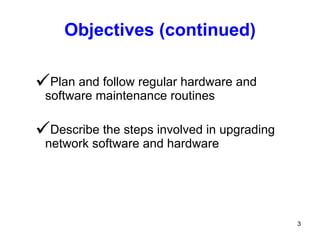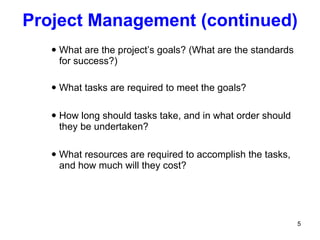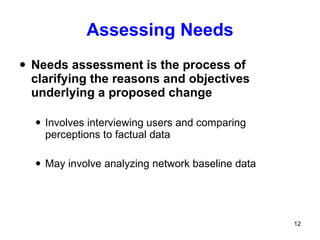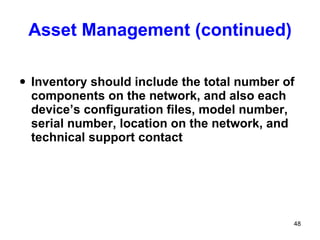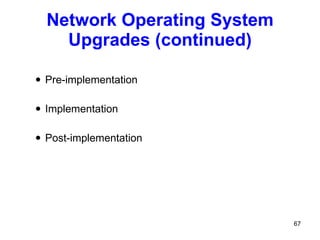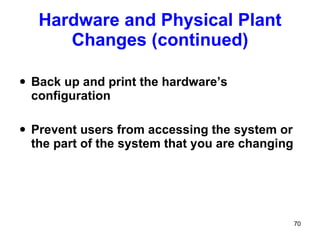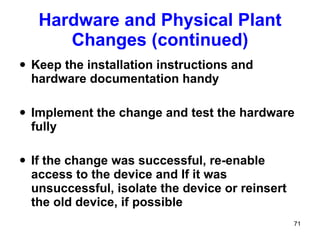Chapter15 -- implementing and managing networks
- 1. Chapter 15: Implementing and Managing Networks Network+ Guide to Networks
- 2. Objectives Describe the elements and benefits of project management Manage a network implementation project Understand network management and the importance of base lining to assess a network’s health
- 3. Objectives (continued) Plan and follow regular hardware and software maintenance routines Describe the steps involved in upgrading network software and hardware
- 4. Project Management Project Management Is the practice of managing resources, staff, budget, timelines, and other variables to achieve a specific goal within given bounds Project management attempts to answer at least the following questions in roughly the following order: Is the proposed project feasible? What needs must the project address?
- 5. Project Management (continued) What are the project’s goals? (What are the standards for success?) What tasks are required to meet the goals? How long should tasks take, and in what order should they be undertaken? What resources are required to accomplish the tasks, and how much will they cost?
- 6. Project Management (continued) Who will be involved and what skills must they possess? How will staff communicate with others about the project? After completion, did the project meet the stated need? A project can be divided into four phases
- 8. Determining Project Feasibility Before committing money and time to a project, you must decide whether the proposed project is possible and whether it’s feasible Feasibility study outlines the costs and benefits of the project and attempts to predict whether it will result in a favorable outcome
- 9. Determining Project Feasibility (continued) Feasibility study might consist of rough estimates for the following: Costs of equipment, connectivity, consulting services Required staff time for project participation, training, and evaluation
- 10. Duration of project Decrease in productivity due to disruption versus increase in future productivity due to better network and client performance A conclusion that addresses whether the costs (equipment, staff, decreased productivity) justify the benefits (increased ongoing productivity) Determining Project Feasibility (continued)
- 11. Determining Project Feasibility (continued) Often, organizations hire business consultants to help them develop a feasibility study Advantage to outsourcing this work is that consultants do not make the same assumptions that internal staff might make when weighing the costs and benefits of a proposed project
- 12. Assessing Needs Needs assessment is the process of clarifying the reasons and objectives underlying a proposed change Involves interviewing users and comparing perceptions to factual data May involve analyzing network baseline data
- 13. Assessing Needs (continued) A needs assessment may address the following questions: Is the expressed need valid, or does it mask a different need? Can the need be resolved?
- 14. Assessing Needs (continued) Is the need important enough to allocate resources to its resolution? Will Meeting the need have a measurable effect on productivity?
- 15. Assessing Needs (continued) If fulfilled, will the need result in additional needs? Will fulfilling the need satisfy other needs? Do users affected by the need agree that change is a good answer? What kind of resolution will satisfy them?
- 16. Assessing Needs (continued) A network’s needs and requirements should be investigated as they relate to: Users Network performance
- 17. Assessing Needs (continued) Availability Scalability Integration Security
- 18. Setting Project Goals Project goals help keep a project on track Evaluating whether a project was successful A popular technique for setting project goals is to begin with a broad goal, then narrow it down into specific goals that contribute to the larger goal Project goals should be attainable
- 19. Setting Project Goals (continued) Feasibility study should help determine whether you can achieve the project goals within the given time, budgetary, and resource constraints
- 20. Setting Project Goals (continued) If project goals are not attainable from the outset, you risk losing backing from project participants, users, and the managers who agree with the project’s goals and who will strive to help you achieve them
- 21. Setting Project Goals (continued) Managers and others who oversee resource allocation are called sponsors
- 22. Project Planning Project plan organizes the details of a managed project Small projects may take the form of a simple text or spreadsheet document
- 23. Project Planning (continued) Larger projects, however, you typically take advantage of project management software such as Microsoft Project or PrimaVera Project Planner Project management software facilitates project planning by providing a framework for inputting tasks, timelines, resource assignments (identifying which staff are responsible for each task), completion dates, and so on
- 25. Tasks and Timelines Project should be divided into specific tasks Break larger tasks into smaller subtasks Identify tasks, you can assign a duration, start date, and finish date to each task and subtask in the project plan
- 26. Tasks and Timelines (continued) Designate milestones, task priority, and how the timeline might change depending on resource availability or dependencies A Gantt chart is a popular method for depicting when projects begin and end along a horizontal timeline
- 27. Tasks and Timelines (continued)
- 28. Communication Communication is necessary to ensure that all participants understand the project’s goals It helps keep a project’s budget and timeline on track, encourage teamwork, avoid duplicate efforts, and allows learning from previous mistakes
- 29. Communication (continued) Project manager is responsible for facilitating regular, effective communication among project participants Project managers must ensure consistent communication with all project stakeholders
- 30. Communication (continued) A stakeholder is any person who is affected by the project; for example, in the Wyndham School District upgrade project, stakeholders include: Teachers Administrators Technical staff Students, because students are also network users
- 31. Contingency Planning Unforeseen circumstances Contingency planning Pilot Network The following tips will help you create a more realistic and useful pilot network:
- 32. Include at least one of each type of device (whether a critical router or a client workstation) that might be affected by the change Use the same transmission methods and speeds as employed on your network Contingency Planning (continued)
- 33. Try to emulate the number of segments, protocols, and addressing schemes in your network. Implement the same server and client software and configurations on your pilot network as found in your current network (unless they are part of the change you’re testing) Contingency Planning (continued)
- 34. Once you have established the pilot network Test it for at least two weeks to verify that its performance, security, availability, or other characteristics meet your criteria Contingency Planning (continued)
- 35. Network Management Network management refers to the assessment, monitoring, and maintenance of all aspects of a network Baselining is the practice of measuring and recording a network’s current state of operation
- 36. Baselining
- 37. Baseline assessment should address the following questions: Access method Protocols Devices Operating systems Applications
- 38. Performance and Fault Management Performance management (monitoring how well links and devices are keeping up with the demands placed on them) Fault management (the detection and signaling of device, link, or component faults)
- 39. Performance and Fault Management (continued) To accomplish both performance and fault management, organizations often use enterprise-wide network management software Polling Network management agent
- 40. Performance and Fault Management (continued) Management information base (MIB) by definition are where managed objects and their data are collected Agents communicate information about managed objects via any one of several Application layer protocols
- 41. Performance and Fault Management (continued) Once data is collected, the network management program can present an administrator with several ways to view and analyze the data
- 43. Network Status
- 44. Network Management (continued) One of the most common network management tools used on WANs is the Multi Router Traffic Grapher (MRTG) MRTG is a command-line program that uses SNMP to poll devices, collects data in a log file, then generates HTML-based views of the data
- 45. Network Management (continued) MRTG is freely distributed software originally written by Tobias Oetiker MRTG can be used with UNIX- and Windows-based operating systems and can collect and graph data from any type of device that uses SNMP
- 47. Asset Management A key component in network evaluation is identifying and tracking the hardware and software on your network, a process called asset management Asset management is to take an inventory of each node on the network
- 48. Asset Management (continued) Inventory should include the total number of components on the network, and also each device’s configuration files, model number, serial number, location on the network, and technical support contact
- 49. Software Changes 1. Determine whether the change (whether it be a patch, revision, or upgrade) is necessary 2. Research the purpose of the change and its potential effects on other programs 3. Determine whether the change should apply to some or all users and whether it will be distributed centrally or machine-by-machine
- 50. Software Changes (continued) 4. If you decide to implement the change, notify system administrators, help desk personnel, and users. Schedule the change for completion during off hours (unless it is an emergency) 5. Back up the current system or software before making any modifications
- 51. Software Changes (continued) 6. Prevent users from accessing the system or part of the system being altered (for example, disable logons) 7. Keep the upgrade instructions handy and follow them during installation of the patch or revision 8. Make the change
- 52. Software Changes (continued) 9. Test the system fully after the change 10. If the change was successful, reenable access to the system and if it was unsuccessful, revert to the previous version of the software
- 53. Software Changes (continued) 11. Inform system administrators, help desk personnel, and users when the change is complete. If you had to reverse it, explain why 12. Record your change in the change management system.
- 54. Patches A general rule, upgrading or patching software according to a vendor’s recommendations is a good idea and can often prevent network problems
- 55. Patches (continued) Patches is a correction, improvement, or enhancement to a particular piece of a software program Differs from a revision or software upgrade in that it changes only part of a software program, leaving most of the code untouched Are often distributed at no charge by software vendors in an attempt to fix a bug in their code or to add slightly more functionality
- 56. Client Upgrades Software upgrade is a major change to a software package’s existing code An upgrade to the client program replaces the existing client program
- 57. Client Upgrades (continued) Upgrades are designed to add functionality and fix bugs in the previous version of the client A client upgrade may be transparent to users, or it may completely change the appearance of the network logon interface
- 58. Application Upgrades Application upgrades, apply to software shared by clients on the network Back up the current software before upgrading it
- 59. Application Upgrades (continued) Prevent users from accessing the software during the implementation Keep users and system administrators informed of all changes.
- 60. Network Operating System Upgrades Most Critical Involves significant, potentially drastic, changes to the way your servers and clients operate Have a project plan covering the upgrade procedure
- 61. Network Operating System Upgrades (continued) How will the upgrade affect user IDs, groups, rights, and policies? How will the upgrade affect file, printer, and directory access, applications or client interactions on the server?
- 62. Network Operating System Upgrades (continued) How will the upgrade affect configuration files, protocols, and services running on the server? How will the upgrade affect the server’s interaction with other devices on the network?
- 63. Network Operating System Upgrades (continued) How accurately can you test the upgrade software in a simulated environment? How can you take advantage of the new operating system to make your system more efficient?
- 64. Network Operating System Upgrades (continued) What is your technical support arrangement with the operating system’s manufacturer if you need help in the midst of the upgrade? Have you allotted enough time to perform the upgrade? (For example, would it be more appropriate to do it over a weekend rather than overnight?)
- 65. Network Operating System Upgrades (continued) Have you ensured that the users, help desk personnel, and system administrators Understand how the upgrade will affect their daily operations and support burdens?
- 66. Network Operating System Upgrades (continued) The following steps demonstrate how careful planning and a methodical process can help you accomplish an NOS upgrade Research Proposal Evaluation Training
- 67. Network Operating System Upgrades (continued) Pre-implementation Implementation Post-implementation
- 68. Reversing a Software Upgrade
- 69. Hardware and Physical Plant Changes Determine whether the change is necessary Research the upgrade’s potential effects on other devices, functions, and users Notify system administrators, help desk personnel, and users, and schedule it during off-hours (unless it is an emergency)
- 70. Hardware and Physical Plant Changes (continued) Back up and print the hardware’s configuration Prevent users from accessing the system or the part of the system that you are changing
- 71. Hardware and Physical Plant Changes (continued) Keep the installation instructions and hardware documentation handy Implement the change and test the hardware fully If the change was successful, re-enable access to the device and If it was unsuccessful, isolate the device or reinsert the old device, if possible
- 72. Hardware and Physical Plant Changes (continued) Inform system administrators, help desk personnel, and users when the change is complete. If it was not successful, explain why Record your change in the change management system
- 73. Adding or Upgrading Equipment Networked workstation is the simplest device to add Networked printer is easy to add to your network and is slightly more complex than adding a networked workstation HUB (4-64 users)
- 74. Adding or Upgrading Equipment Servers are more complex and need a great deal of prior planning Switches and Routers are more complex
- 75. Adding or Upgrading Equipment (continued) Cabling upgrades may require significant planning and time to implement, depending on the size of your network Backbone upgrade is the most comprehensive and complex upgrade involving a network
- 76. Adding or Upgrading Equipment (continued) Reversing Hardware Changes Provide a way to reverse the hardware upgrade and reinstall the old hardware if necessary
- 77. Summary Describe the elements and benefits of project management Manage a network implementation project Base-lining to assess a network’s health
- 78. Summary (continued) Hardware and software maintenance routines Steps involved in upgrading network software and hardware


